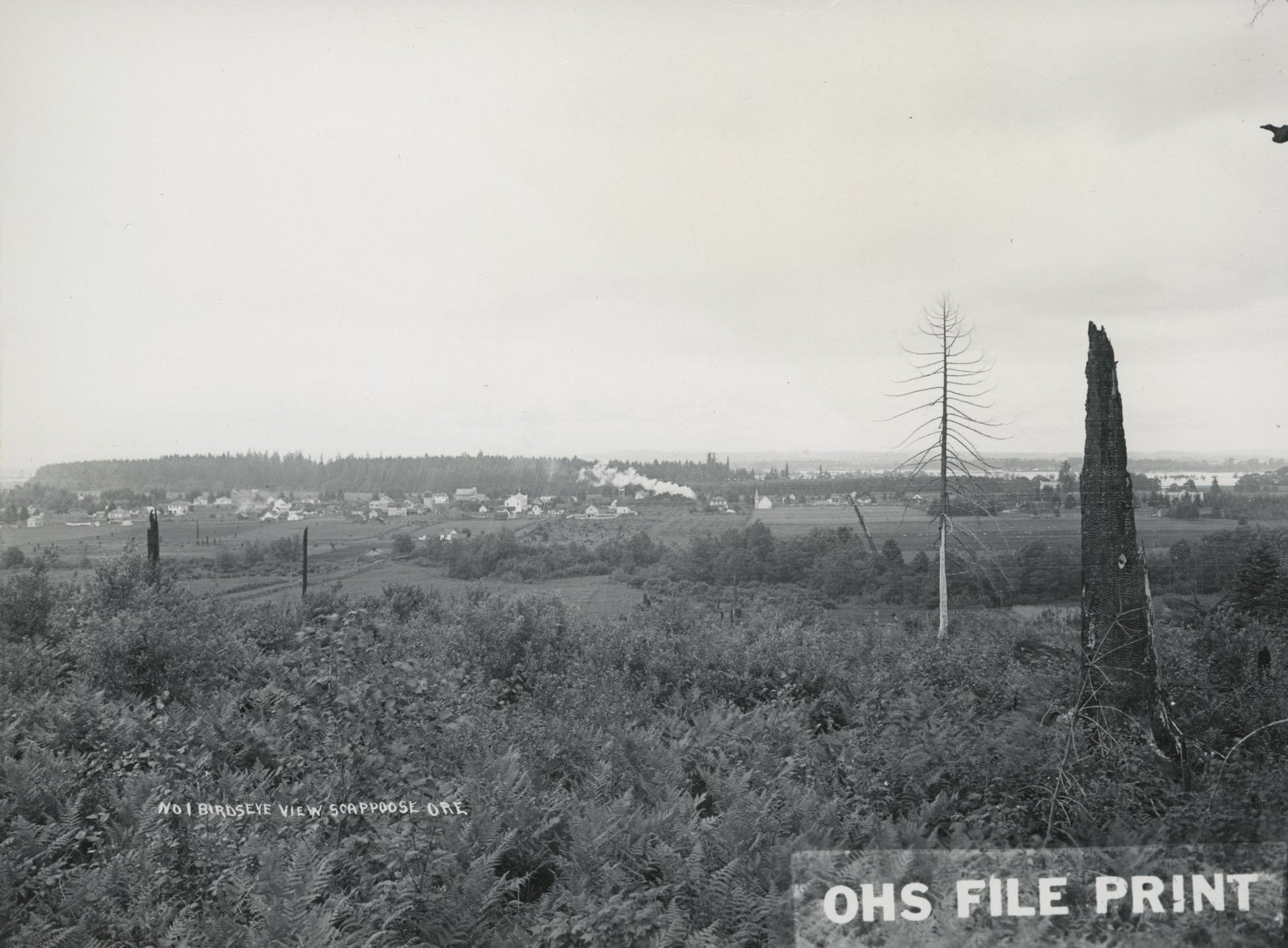
Scappoose, the Beginning: 1830-1852
In 1852 the first industrial business started in Scappoose. The building of the saw mill by Timothy Lamberson and Malcom McKay brought the birth of a town.
Scappoose has a history that dates back to the original inhabitants who were the Chinook Indians and other Northwest tribes. Scappoose's name* is derived from the Chinook Tribe and means "gravelly plains". Our area served as prime Indian hunting grounds and was led by Chief Concomley. The Chief held stewardship over his people and the land.
At one time, Scappoose was covered with wild grasses and ancient forests and fed herds of elk and deer. The river supplied spawning beds for salmon and other migrating fish. While we still enjoy the wildlife and fishing, the ancient forests have disappeared.
The area was a meeting place for the Tribes to gather in what is known as a "Pow Wow". Until recently, Scappoose honored this heritage by our annual Pow Wow/Summerfest event, last held in 2015.
When Chief Concomley died in 1830, Chief Cassino of the Kiersinno Tribe (who was married to Leche, the eldest daughter of Chief Concomley) became the highest-ranking chief of the Northwest Chinook Tribes.
The first non-native to arrive was Thomas McKay, stepson of John McLaughlin of the Hudson Bay Company. He was a trapper and hunter and created a special bond with Chief Concomley. In later years, Thomas married Tomee, the daughter of Chief Concomley.
Starting in 1828, the abundant natural resources of the Northwest called to the early settlers. They came from Missouri, Kansas, Nebraska, and other Eastern states.
In 1842, the first covered wagons rolled into Scappoose. As the area settled, folks came from as far away as Czechoslovakia and Switzerland and developed a large presence in early Scappoose.
1852 marks the arrival of the Watts Family.
*There are also references to the name Scappoose being derived from a Chinookan village, on the west side of the Multnomah Channel, called Skáppus. Reference: Oregon Encyclopedia, article by Cessna (Duke) Smith

Scappoose: 1852-1870
1870 - William West donated six acres to the railroad to build a depot and switching yards if they would call it Scappoose Depot.
In 1852, William Watts (Grandfather to James Grant Watts) and his family arrived in Scappoose. William journeyed across the Oregon Trail with his wife and children to reach their promised land. Upon their successful arrival, William and his eldest son, Benjamin, participated in the Land Grant Claim Act. William was granted 640 acres, while Benjamin received 320 acres.
The year 1853 marked the establishment of the first organized school. A wooden schoolhouse consisting of four rooms was erected in 1854.
In 1856, the first post office was constructed at Brown's Landing on the Multnomah Channel.
The year 1863 witnessed an influx of settlers to the valleys and canyons west of Scappoose due to the Homestead Act. These settlers arrived via stern wheelers, trains, oxen carts, and established trails and roads. Traveling posed challenges as the roads were often muddy and wet for a significant part of the year. Nevertheless, the settlers persevered, building their lives and various businesses, including dairy, cattle, and poultry farms, lumbering, and horticultural ventures. Mercantiles, banks, restaurants, boarding houses, and other enterprises also became integral parts of the town's landscape.
1869 marked the completion of the Transcontinental railroad.
In 1870, Congress passed an Act requiring landowners to donate some of their land for the completion of the railroad and telegraph line between Portland and Astoria. William West generously donated six acres to the railroad to build a depot and switching yards on the condition that it be named Scappoose Depot.

Scappoose: 1884-Present
In 1884 the railroad came through Scappoose. The train went as far as Goble, Oregon at which point passengers and train cars were loaded onto barges and ferried across the Columbia River to complete their journey on the Washington side.
In 1884, the railroad reached Scappoose, with the train terminating at Goble, Oregon. Passengers and train cars were then loaded onto barges and ferried across the Columbia River to complete their journey on the Washington side.
In 1883, William West erected the first mercantile establishment, and by 1888, James Grant Watts and his brother-in-law D.W. Price had acquired the store, renaming it "Watts and Price General Merchandise".
By 1894, the business district had taken shape between the Columbia River Highway and SW First Street. Watts and Price General Merchandise, identifiable by its tower, stood as a prominent landmark.
In 1915, a fire originating in Lilly Shell's boarding house ravaged half of the business district and six residences, miraculously sparing Watts and Price Mercantile.
In 1920, James Grant Watts was elected as Scappoose's first Mayor.
1921 marked Scappoose's incorporation as a City, accompanied by the establishment of its first City Charter. This historic event occurred in Mayor Watts's residence.
In 1930, another devastating fire swept through the City, including Watts and Price Mercantile.
Between 1931 and 1959, Scappoose underwent a period of rebuilding, witnessing the installation of its first electric lights, city water system, public library, and improved schools.
Throughout the remainder of the decade, Scappoose experienced steady growth, attracting residents seeking a more relaxed lifestyle away from the bustle of Portland.
The turn of the millennium brought continued population growth, marked by the establishment of housing developments and the ebb and flow of businesses.
Today, small businesses thrive in Scappoose, serving as the community's lifeblood. The town boasts an aviation district with a small airport, while Highway 30 is adorned with shops and professional offices. Despite these developments, the citizens of Scappoose cherish their small-town atmosphere.















